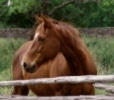September 1, 2009

Equine owners should be extra vigilant for signs of pigeon fever in horses, warns
Colorado State University veterinarians.
A spike in the disorder is reported in the northern Front Range of the Colorado Rocky Mountains.
This highly contagious disease is also pigeon breast, breastbone fever, false strangles or dryland distemper. Signs of pigeon fever can initially resemble those of strangles or dryland distemper, report officials of the CSU Veterinary Teaching Hospital.
Sometimes the only initial signs are lameness and a reluctance to move. Other signs include fever, lethargy and weight loss.
There also may be very deep abscesses and multiple joint sores along the horse's chest, midline and groin area. Abscesses in other areas such as the back, flank or ears have been seen, but internal abscesses are rare. Horses can be infected for several weeks before developing outward symptoms, particularly abscesses.
The potentially fatal disease caused by Corynebacterium pseudotuberculosis, can enter horse bodies through wounds, broken skin or mucus membranes. Research also indicates that the disease may be spread by flies, particularly cattle horn flies.
Pigeon fever can hit horses at any age, and does not discriminate by sex or breed. Usually, however, it is seen on younger animals. Humans cannot contract this disorder, but can carry it to other horses. Shoes, clothing, hands and barn tools can all help spread the fever.
Any horse suspected of having pigeon fever should be isolated to prevent spread to other animals. Areas where infected horses are held must be properly cleaned and completely disinfected.
Treatment requires hot packs or poultices that are applied to abscesses. Open abscesses are drained and regularly flushed with saline. Veterinarians may need to lance deep abscesses.
Vets also may prescribe anti-inflammatory drugs to control swelling and pain, and sometimes use an antibiotic.
Horses with the disease usually recover within a few weeks with proper treatment. If caught early enough, horses normally make a total recovery, but the disorder may return.
You May Also Like




